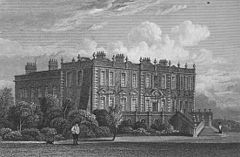 The place name Sefton is of Saxon origin and is descriptive of the low-lying land of the parish which in earlier times would flood every winter. The name might be translated as settlement by the sedges or rushes. After the Norman Conquest this land was conferred upon William de Moline or Molyneux and the Sefton (or Moline) cross, which now serves as the logo for Sefton Metropolitan Borough, was the heraldic emblem of the Molyneux family.
The place name Sefton is of Saxon origin and is descriptive of the low-lying land of the parish which in earlier times would flood every winter. The name might be translated as settlement by the sedges or rushes. After the Norman Conquest this land was conferred upon William de Moline or Molyneux and the Sefton (or Moline) cross, which now serves as the logo for Sefton Metropolitan Borough, was the heraldic emblem of the Molyneux family.Early representations of the Moline Cross can be seen carved in the entryway to St Helen's Church in the old village of Sefton.
Sefton lies on the river Alt which in former times was a more substantial waterway than we find today. It was navigable as far as Croxteth, a ninth century Norse settlement about nine miles upriver, where in 1575 Molyneux, by this time Earl of Derby, moved into the newly built Croxteth Hall. This remained the family seat until 1972 when the seventh and last earl died. At this time the estate was acquired by the city of Liverpool .

River Alt at midsummer sunrise.
The norse name Croxteth derives from Croc's Staithe or landing place and many other place names in this part of south west Lacashire bear witness to the viking influence in this area. When the nearby M62 motorway was being built in 1975 evidence of this of this was confirmed when the remains of a viking longboat were uncovered during earth moving at theTarbock exit.
Over recent centuries the meadows of the Alt plain have undergone significant improvement and former peat mosses are now good quality agricultural land. Even so, until the construction of floodgates at Altmouth in 1830 the river remained tidal as far as Showrick Bridge by Sefton village and even with the present complex nexus of drainage ditches and pumping stations the Alt can still be capricious. As Alison Maddock in her 1999 study asserted: this "small river [bears] influence on life and livelihood in the area out of all proportion to its size".
In the last couple of years and after prolonged debate a radical flood prevention scheme has been implemented. This has involved the surrender of improved farmland in favour of the creation at Lunt Meadows of 70 hectares of permanent reedbed and floodplain grazing marsh. This is designed to alleviate the threat of flooding to the nearby township of Formby by allowing the Alt to overspill in a managed way as and when the situation demands. At such times a significant diversion of the river might be achievable. When the Environment Agency has completed its work, the management of Lunt Meadows will pass to Lancashire Wildlife Trust.
In my lifetime a wetland area of similar size, immediately adjacent, was used as rubbish landfill; this has in the last two decades been planted with broadleaf trees as part of the Mersey Forest project and now forms a pleasant addition to the local ecology. Ironically, however, this seems to demonstrate the short-sightedness of planners who destroyed the original watermeadow system only to realise immediately afterwards the essential function that this natural feature had been fulfilling.
The landscaping of Lunt Meadows Wetlands proved interesting indeed. A hundred meters or so from Showrick Bridge, an ancient crossing place, a Mesolithic site was revealed. This might be thought remarkable enough all ready, perhaps, but this site challenged the received wisdom of how Mesolithic society had been organised. It was previously thought that Mesolithic man lived a hunter-gatherer existence which involved no settled dwellings but the 7,800 year old remains, found at Lunt, showed that Mesolithic society was a great deal more socially organised than previously had been thought. Evidence of three permanent structures was found which reveals that a settled community of three or so families had in those days established themselves here and returned at least seasonally over a period of time. The archaeologist in charge of the find, Dr Ron Cowell, explained how this demonstrated that our forbears at this time were not the constantly moving nomads we had previously assumed them to be and confirmed the evidence of similar finds at Howick in Northumberland and near Scarborough in Yorkshire.



In the springtime of the year the wildflowers and birdsong of this tranquil place are spellbinding.
Feedback, comments and interesting links always welcome.
Links:
https://www.flickr.com/photos/formbycivicsociety/8744314477/
http://www.theguardian.com/science/2012/nov/19/stone-age-nomads-merseyside-dwellings
http://www.bbc.co.uk/news/uk-england-20344575
http://megalithix.wordpress.com/2011/03/23/st-helens-well-sefton/
http://plus.google.com/+ColinMcIndoecolmacro48/posts

















